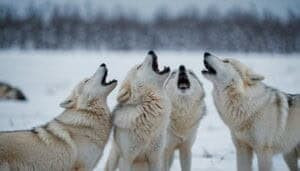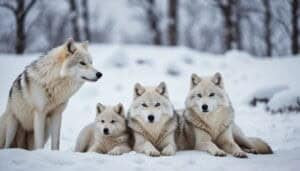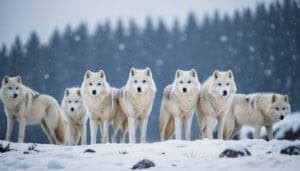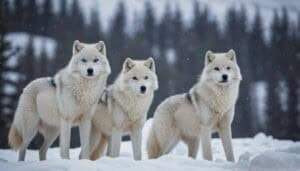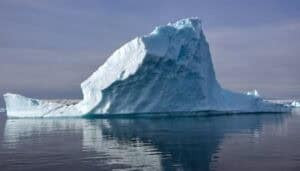Introduction
The Arctic ecosystem is a harsh and fascinating environment where various predators, including the Arctic wolf, interact in complex ways
This article explores the interactions of Arctic wolves with other key predators such as polar bears, Arctic foxes, and snowy owls. We will delve into the characteristics of these predators, their relationships, and how environmental changes impact these dynamics
By examining scientific studies, we aim to provide a comprehensive understanding of the predator interactions in this unique ecosystem
Introduction to Arctic Wolves and Their Ecosystem
The Arctic ecosystem is a unique and challenging environment, home to a diverse range of species that have adapted to survive in extreme conditions. Arctic wolves, a key predator in this ecosystem, have developed various traits and behaviors to thrive in this harsh climate
Overview of the Arctic Ecosystem
The Arctic ecosystem encompasses the northernmost regions of the Earth, characterized by its icy landscapes, frigid temperatures, and long periods of darkness during the winter
This biome includes the Arctic Ocean, surrounding seas, and parts of Canada, Russia, Greenland, Norway, and the United States (Alaska). The extreme conditions require special adaptations from its inhabitants, including insulation, specialized hunting techniques, and unique social behaviors
Despite its seemingly barren environment, the Arctic is teeming with life. From microscopic plankton to the towering polar bear, each organism plays a crucial role in maintaining the balance of this ecosystem. Primary producers such as algae and lichens form the base of the food web, supporting herbivores like caribou and hares, which in turn sustain the predators
Characteristics of Arctic Wolves
Arctic wolves (Canis lupus arctos) are a subspecies of the gray wolf, specifically adapted to the Arctic environment
These wolves are smaller and whiter than their southern relatives, an adaptation that provides better camouflage against the snow and ice. Their thick fur, padded paws, and a layer of fat help them withstand the freezing temperatures
Arctic wolves are social animals, typically living in packs that range from two to twenty members
This social structure aids in hunting and provides protection against larger predators. They primarily hunt caribou and muskoxen, but their diet also includes smaller mammals, birds, and even fish when available. Their ability to travel long distances in search of food is a testament to their resilience and adaptability
Primary Predators and Their Interactions
The Arctic is home to several apex predators that play critical roles in the ecosystem. Understanding their behaviors and interactions is key to comprehending the balance of this fragile environment
This section explores the primary predators of the Arctic—polar bears, Arctic foxes, and snowy owls—and their interactions with Arctic wolves
Polar Bears
Polar bears (Ursus maritimus) are the largest land carnivores in the Arctic, primarily preying on seals. They are solitary animals, relying on sea ice to hunt for food. As apex predators, polar bears have minimal natural enemies, but they occasionally encounter other Arctic predators, including wolves
Polar bears are highly adapted to the cold, with thick blubber and dense fur for insulation
Their powerful limbs and large paws enable them to swim vast distances and traverse icy terrain. Despite their dominance, polar bears face significant challenges due to the rapid melting of sea ice, which affects their ability to hunt and find food
Arctic Foxes
Arctic foxes (Vulpes lagopus) are smaller predators that exhibit remarkable adaptability to the extreme Arctic conditions
They have a varied diet that includes lemmings, birds, fish, and carrion. Their thick fur changes color with the seasons—white in winter for camouflage against the snow and brown in summer to blend with the tundra
These foxes are opportunistic feeders and often follow polar bears to scavenge leftovers from their kills. While Arctic foxes are not direct competitors with Arctic wolves for large prey, they share similar ecological niches and sometimes compete for smaller food sources
Snowy Owls
Snowy owls (Bubo scandiacus) are iconic Arctic birds of prey. Known for their striking white plumage and piercing yellow eyes, these owls primarily hunt small mammals like lemmings. They are migratory birds, often traveling to more temperate regions during the winter
Snowy owls are highly territorial and have keen hunting skills, which position them as formidable predators in their own right. Their interactions with Arctic wolves are less direct but still significant, as both species influence the populations of their common prey
Interactions With Arctic Wolves
Interactions between Arctic wolves and other predators vary depending on the species and circumstances. These interactions can be competitive, neutral, or even cooperative, influenced by factors such as prey availability and environmental conditions
Arctic Wolves and Polar Bears
Arctic wolves and polar bears occasionally encounter each other, especially near coastal areas where both species hunt
While direct confrontations are rare due to the size and strength of polar bears, wolves may scavenge from polar bear kills or avoid them altogether to prevent conflict. Polar bears, on the other hand, typically ignore wolves unless food competition arises
Studies have documented instances where wolves have successfully scavenged from polar bear kills, benefiting from the bears’ hunting prowess. However, this opportunistic behavior can sometimes lead to tension if a polar bear perceives the wolves as a threat to its food supply
Arctic Wolves and Arctic Foxes
The relationship between Arctic wolves and Arctic foxes is complex. While wolves primarily hunt larger prey, foxes often target smaller animals. However, in times of scarcity, wolves might hunt smaller prey, leading to competition with foxes
Foxes are known to follow wolf packs, scavenging on leftover kills. This symbiotic relationship benefits the foxes, but it can also result in conflict if food resources are limited. Despite this competition, both species coexist by exploiting different niches within the ecosystem
Arctic Wolves and Snowy Owls
Interactions between Arctic wolves and snowy owls are less direct but still noteworthy
Both species prey on similar small mammals, leading to occasional competition for food. However, given the differing hunting methods and times of activity—wolves being primarily nocturnal and owls often hunting during twilight—direct encounters are infrequent
Snowy owls’ presence can influence the behavior of small mammals, indirectly affecting the wolves’ hunting success. For example, a high population of owls might reduce the number of small mammals available for wolves, pushing them to seek alternative prey or adapt their hunting strategies
Adaptations and Hunting Strategies of Arctic Wolves
Arctic wolves have evolved numerous adaptations and strategies to survive and thrive in the harsh Arctic environment. These adaptations are crucial for their survival, particularly in securing food and coping with extreme weather conditions
Seasonal Adaptations
Arctic wolves exhibit various seasonal adaptations to survive the extreme temperatures and changing conditions of the Arctic
During the winter months, they rely on their thick, double-layered fur to insulate against the cold. This fur includes a dense undercoat and longer guard hairs that repel water and snow. Their fur also changes color, becoming whiter in the winter to provide better camouflage against the snow
In addition to physical adaptations, Arctic wolves adjust their behavior seasonally
During the winter, they form larger packs to hunt more efficiently, particularly targeting large prey like caribou and muskoxen, which are more challenging to catch alone. The pack’s social structure and coordinated hunting techniques increase their chances of a successful hunt
In the summer, as prey becomes more abundant and dispersed, Arctic wolf packs often break into smaller groups or pairs. This seasonal dispersal reduces competition for food within the pack and allows them to cover more ground while hunting smaller animals such as hares, birds, and rodents
Hunting Techniques
Arctic wolves are highly skilled hunters, employing various techniques to capture their prey. Their hunting strategies depend on the type and size of the prey, the season, and the pack’s size
For larger prey like caribou and muskoxen, Arctic wolves use cooperative hunting tactics. The pack works together to isolate a weak, young, or old individual from the herd
They use their endurance to chase the prey over long distances, wearing it down before making the final attack. The pack’s alpha pair often leads the hunt, coordinating the other members’ movements to encircle and bring down the prey
When hunting smaller prey, Arctic wolves rely more on stealth and agility. They use their keen sense of smell and hearing to locate animals hiding beneath the snow or in burrows. In the summer, they might dig out rodents or chase down birds and hares, using short bursts of speed to catch them off guard
Arctic wolves are also opportunistic feeders, meaning they will scavenge when the opportunity arises
They may follow other predators like polar bears to scavenge leftovers from their kills or feed on carcasses of animals that have died from natural causes. This flexibility in their diet and hunting techniques is crucial for their survival in an environment where food availability can be unpredictable
Impact of Environmental Changes on Predator Interactions
The Arctic ecosystem is particularly sensitive to environmental changes, which can significantly impact predator interactions. Climate change, human activities, and other factors influence the behavior, distribution, and survival of Arctic predators, including Arctic wolves
Climate Change Effects
Climate change poses one of the most significant threats to the Arctic ecosystem. The rapid warming of the region has led to a reduction in sea ice, altered precipitation patterns, and increased temperatures. These changes have profound effects on the interactions between Arctic wolves and other predators
One of the most visible impacts of climate change is the loss of sea ice, which directly affects polar bears
As the sea ice diminishes, polar bears are forced to spend more time on land, increasing their encounters with Arctic wolves. This can lead to more competition for food resources, as both species may target similar prey when their traditional food sources become scarce
Additionally, the shifting distribution of prey species due to changing vegetation patterns and temperatures can alter predator-prey dynamics. For example, caribou and muskoxen, key prey for Arctic wolves, may change their migratory routes and population densities in response to climate change, influencing wolf hunting success and pack dynamics
Studies have shown that climate change can also affect the reproductive success and survival rates of Arctic wolves. Warmer temperatures and altered snow conditions can impact denning sites and pup survival, leading to potential long-term declines in wolf populations (Mech, 2017)
Human Activities
Human activities in the Arctic, such as oil and gas exploration, mining, and increased shipping traffic, also impact predator interactions. Habitat fragmentation and pollution disrupt the natural behaviors and distribution of Arctic species, including wolves and their prey
Industrial activities can lead to habitat loss, reducing the availability of hunting grounds and denning sites for Arctic wolves
Increased human presence and infrastructure can also disturb wildlife, causing stress and altering their natural behaviors. For instance, noise pollution from industrial operations can interfere with the wolves’ communication and hunting efficiency
Moreover, human activities often lead to increased food availability in the form of waste and garbage, which can attract predators and create unnatural food sources. This can lead to increased human-wildlife conflicts and alter the natural predator-prey relationships in the region
Conservation efforts are crucial to mitigating these impacts. Protected areas and wildlife corridors can help preserve critical habitats and allow for the natural movement and interactions of Arctic predators. Policies to reduce carbon emissions and combat climate change are also essential to safeguarding the future of the Arctic ecosystem and its inhabitants
Scientific Studies on Predator Interactions in the Arctic
Research on predator interactions in the Arctic provides valuable insights into the complex dynamics of this unique ecosystem. Numerous studies have examined the behaviors, adaptations, and interactions of Arctic predators, shedding light on their roles and relationships within the food web
Key Research Findings
Scientific studies have revealed a wealth of information about how Arctic predators interact
For example, research has shown that Arctic wolves and polar bears have occasional interactions, primarily driven by food availability. A study by L. David Mech (2015) documented instances of wolves scavenging from polar bear kills, highlighting an opportunistic aspect of their behavior
Another significant finding is the impact of climate change on predator-prey dynamics. A study published in the journal Nature Climate Change (2017) found that diminishing sea ice forces polar bears onto land for longer periods, increasing their encounters with other terrestrial predators like Arctic wolves
This overlap can lead to heightened competition for limited food resources, particularly during the summer months when prey is more dispersed
Research has also focused on the symbiotic relationships between predators. For example, studies on Arctic foxes following wolf packs to scavenge on leftovers illustrate a form of commensalism, where the foxes benefit from the wolves’ hunting efforts without significantly affecting the wolves
Future Research Directions
Despite the extensive research conducted, there are still many areas that require further investigation
Future research could focus on the long-term effects of climate change on predator interactions and the broader Arctic food web. Understanding how shifts in prey availability and habitat changes influence predator behaviors and relationships is crucial for predicting the future dynamics of the Arctic ecosystem
Another area for future study is the impact of increased human activity on predator interactions. As industrial development continues in the Arctic, understanding how these activities affect wildlife can inform conservation strategies and policies to mitigate negative impacts
Advancements in tracking technology and remote sensing offer new opportunities for studying Arctic predators in greater detail. These technologies can provide real-time data on animal movements, behaviors, and interactions, allowing researchers to develop more comprehensive models of the Arctic ecosystem
Collaborative research efforts that integrate traditional ecological knowledge from Indigenous communities with scientific studies can also enhance our understanding of Arctic predator interactions. Indigenous knowledge provides valuable insights into the historical and contemporary behaviors of wildlife, contributing to a more holistic view of the ecosystem
Conclusion
Understanding how Arctic wolves interact with other predators in the Arctic ecosystem reveals the intricate balance and adaptability required for survival in this harsh environment. These interactions are shaped by the behaviors and characteristics of primary Arctic predators such as polar bears, Arctic foxes, and snowy owls, as well as the adaptations and hunting strategies of the wolves themselves
Climate change and human activities are profoundly impacting these interactions, leading to shifts in predator-prey dynamics and increased competition for resources. Scientific studies have provided valuable insights into these complex relationships, highlighting the need for ongoing research and conservation efforts to protect the fragile Arctic ecosystem
By examining the various aspects of these predator interactions, from cooperative hunting tactics to the effects of environmental changes, we gain a deeper appreciation for the resilience and adaptability of Arctic wolves and their role in maintaining the ecological balance of the Arctic. As we continue to study and protect this unique ecosystem, we ensure the survival of its inhabitants and the preservation of its natural beauty for future generations



